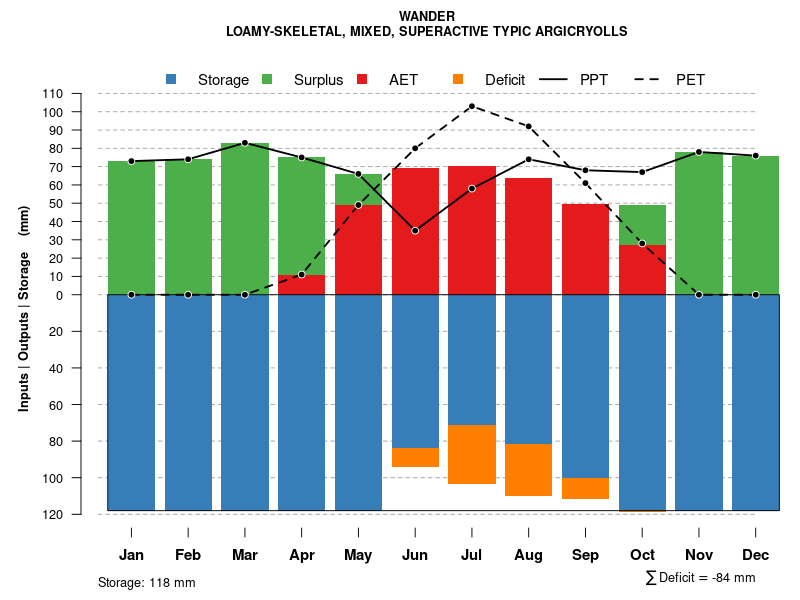| Wander-Hollandlake families, complex, 5 to 25 percent slopes, landslides | 616B | 3359 | 509370 | k319 | co647 | | 1:24000 |
Wander bouldery fine sandy loam, 25 to 65 percent slopes, very stony | 150 | 1629 | 506985 | k0kc | co648 | | 1:24000 |
Wander-Hotter-Hourglass complex, 30 to 60 percent slopes | 610 | 12443 | 507213 | k0sq | co672 | 2003 | 1:24000 |
Hourglass-Wander complex, 5 to 30 percent slopes | 609 | 7179 | 507212 | k0sp | co672 | 2003 | 1:24000 |
Hourglass-Bucklon-Wander complex, 30 to 60 percent slopes | 164 | 5338 | 507105 | k0p7 | co672 | 2003 | 1:24000 |
Wander-Woodhurst-Philipsburg families, complex, gentle mountain slopes | 527C | 71 | 2024050 | 25y5y | id758 | 1998 | 1:24000 |
Wander, stony-Cowood, very stony-Lingshire families, complex, 8 to 45 percent slopes | 6317F | 1488 | 3169253 | 2tymt | mt600 | 1969 | 1:24000 |
Lingshire-Wander, stony-Hourglass families, complex, 4 to 35 percent slopes | 6318E | 1281 | 3005105 | 2tyms | mt600 | 1969 | 1:24000 |
Rock outcrop-Mariaspass, stony-Wander, stony families, complex, 8 to 45 percent slopes | 6324F | 348 | 3169262 | 2tyn0 | mt600 | 1969 | 1:24000 |
Finn, frequently flooded-Wander-Foolhen, rarely flooded families, complex, valley bottoms | 647G | 4640 | 149133 | 505r | mt605 | 2007 | 1:24000 |
Wander-Wetopa-Wesdy families, complex, gentle mountain slopes | 522C | 3248 | 148601 | 4zml | mt605 | 2007 | 1:24000 |
Midfork-Tibson-Wander families, complex, steep mountain slopes | 544C | 1686 | 148905 | 4zyd | mt605 | 2007 | 1:24000 |
Como-Wander-Ledgefork families, complex, valley trough walls | 228X | 1458 | 148558 | 4zl6 | mt605 | 2007 | 1:24000 |
Gateview-Wander-Kamack families, complex, steep mountain slopes | 547C | 1280 | 148710 | 4zr3 | mt605 | 2007 | 1:24000 |
Wander-Woodhurst-Philipsburg families, complex, gentle mountain slopes | 527C | 1160 | 148621 | 4zn7 | mt605 | 2007 | 1:24000 |
Hanson-Wander-Skaggs families, complex, steep mountain slopes | 546C | 1148 | 148696 | 4zqn | mt605 | 2007 | 1:24000 |
Kamack-Ledgefork-Wander families, complex, valley trough walls | 227C | 745 | 149337 | 50db | mt605 | 2007 | 1:24000 |
Philipsburg-Wander-Wetopa families, complex, alluvial-colluvial deposits | 6110C | 452 | 149315 | 50cm | mt605 | 2007 | 1:24000 |
Finn-Wander-Foolhen families, complex, valley bottoms | 647G | 118 | 1531245 | 1ndd0 | mt610 | 2005 | 1:24000 |
Wander-Woodhurst-Philipsburg families, complex, gentle mountain slopes | 527C | 7 | 2911107 | 4zn7 | mt610 | 2005 | 1:24000 |
Finn, frequently flooded-Wander-Foolhen, rarely flooded families, complex, valley bottoms | 647G | 135 | 2597762 | 505r | mt612 | 2011 | 1:24000 |
Gateview-Wander-Kamack families, complex, steep mountain slopes | 547C | 10 | 2597722 | 4zr3 | mt612 | 2011 | 1:24000 |
Helmville, very stony-Storm-Wander families, complex, 15 to 60 percent slopes | 6256F | 5337 | 2838446 | 2v2ss | mt632 | | 1:24000 |
Lingshire-Wander, stony-Hourglass families, complex, 4 to 35 percent slopes | 6318E | 3470 | 2826848 | 2tyms | mt632 | | 1:24000 |
Wander, stony-Cowood, very stony-Lingshire families, complex, 8 to 45 percent slopes | 6317F | 3181 | 2826849 | 2tymt | mt632 | | 1:24000 |
Rock outcrop-Mariaspass, stony-Wander, stony families, complex, 8 to 45 percent slopes | 6324F | 406 | 2826855 | 2tyn0 | mt632 | | 1:24000 |
Helmville, very stony-Storm-Wander families, complex, 15 to 60 percent slopes | 6256F | 80 | 3384191 | 2v2ss | mt633 | | 1:24000 |
Lingshire-Wander, stony-Hourglass families, complex, 4 to 35 percent slopes | 6318E | 1091 | 3005097 | 2tyms | mt663 | 2017 | 1:24000 |
Wander, stony-Cowood, very stony-Lingshire families, complex, 8 to 45 percent slopes | 6317F | 506 | 3005098 | 2tymt | mt663 | 2017 | 1:24000 |
Clayburn family-Wander-Crubas, occasionally poned, complex, 0 to 40 percent slopes | CaE | 2081 | 2862032 | 2vd1d | nm672 | | 1:24000 |
Teeler, extremely stony-Wander-Dromedary families association, 15 to 70 percent slopes | 492 | 768 | 2421230 | 2m8h6 | ut647 | | 1:24000 |
Wander family-Genoa family, extremely stony-Rock outcrop complex, 3 to 25 percent slopes | 209A | 1908 | 791275 | vkd0 | ut651 | | 1:24000 |
Wander family, rubbly-Panin family complex, 15 to 60 percent slopes | 236 | 978 | 791466 | vkl5 | ut651 | | 1:24000 |
Wander-Dollarhide families, complex, 3 to 25 percent slopes | 51 | 745 | 800720 | vw6p | ut651 | | 1:24000 |
Wander very rubbly-Libeg-Rock Outcrop complex, 35 to 90 percent slopes | 6702 | 2060 | 2487344 | 2ph8x | wy635 | | 1:24000 |
Elwood-Wander families, complex, 15 to 25 percent slopes | 239 | 1635 | 157806 | 596j | wy656 | 2008 | 1:24000 |
Wander-Kamack families, complex, 40 to 90 percent slopes -- draft | 236 | 52680 | 151972 | 534b | wy663 | 2012 | 1:24000 |
Wander-Coldfeet-Badwater families, complex, 5 to 40 percent slopes | 223 | 15637 | 151964 | 5342 | wy663 | 2012 | 1:24000 |
Washboard-Midfork-Wander families, complex, 30 to 80 percent slopes | 276 | 7580 | 151985 | 534r | wy663 | 2012 | 1:24000 |
Baird Hollow family-Mollic Haplocryalfs-Wander family, association, 0 to 30 percent slopes | 212 | 6478 | 151958 | 533w | wy663 | 2012 | 1:24000 |
Wander-Kamack families, complex, 40 to 90 percent slopes -- draft | 236 | 12806 | 2611982 | 534b | wy723 | | 1:24000 |
Wander very rubbly-Libeg-Rock Outcrop complex, 35 to 90 percent slopes | 6702 | 1285 | 2554679 | 2ph8x | wy723 | | 1:24000 |














